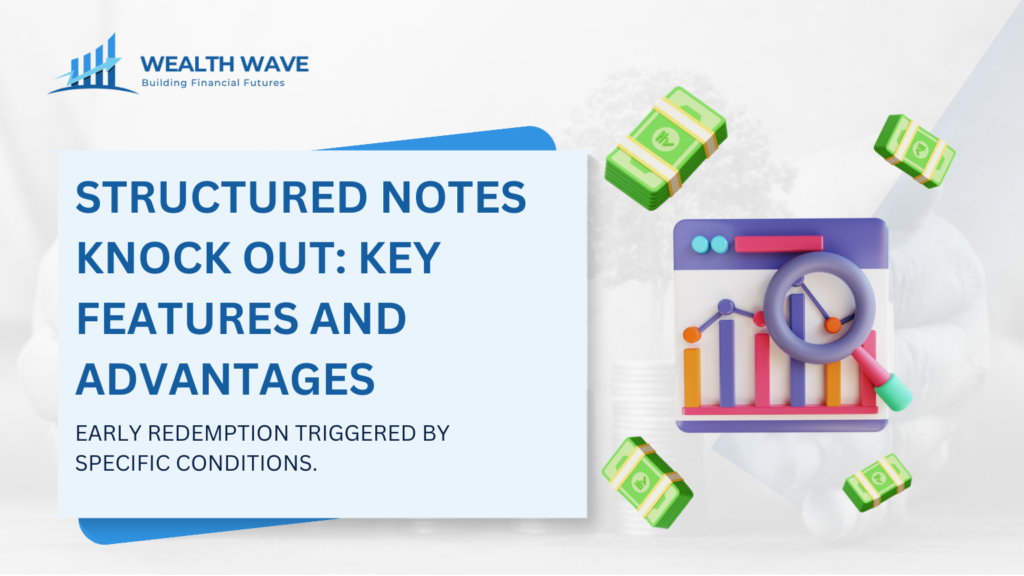
Ever felt baffled by the sea of investment options available, particularly when it comes to structured notes knock out? You’re definitely in good company. Navigating through the complex terms and choices can feel like decoding a secret language.
Interestingly enough, did you know that structured notes are essentially debt securities issued by banks? This piece of information is key to understanding how these sophisticated financial instruments work.
After thoroughly researching and leaning on our own experiences, we’ve put together insights and clear explanations to help demystify structured investments for you. Whether it’s getting a handle on knockout options or figuring out how market-linked growth notes function, our guide aims to illuminate these intricate products.
By focusing on both the potential rewards and risks involved, this article is designed to arm you with the knowledge needed to thoughtfully consider adding structured notes to your investment mix.
Ready to peel back the layers of mystery?
Key Takeaways
- Structured notes are complex financial products that blend the features of debt securities and derivatives, offering a way to invest in assets like equity indexes with added elements such as principal protection.
- Knock-out options in structured notes, including down-and-out and up-and-out types, can stop existing if certain price levels are hit. This adds a layer of risk management but also introduces the potential for significant loss if triggered.
- Leveraging through knock-out options allows investors to aim for higher returns by increasing market exposure. However, this comes with elevated risks, especially if the market moves unfavorably and triggers the knock-out condition.
- Combining structured notes with knock-out options provides unique opportunities for managing investment risk while seeking growth. It’s crucial for investors to understand these mechanisms to make informed decisions aligned with their risk tolerance.
- While structured notes offer potential advantages like enhanced returns due to leveraging and some degree of downside protection, they carry substantial risks that require careful consideration before investment.
Understanding Structured Notes

Structured notes are unique investment products that combine features of both debt and derivatives. They offer a way to gain exposure to different underlying assets while potentially providing principal protection.
Definition

Structured notes are debt securities issued by financial institutions. Their returns depend on the performance of underlying assets, which can be equity indexes or individual stocks.
These investment products have specific mechanisms and features that differentiate them from traditional fixed income instruments. They are not listed on an exchange, making secondary market trading challenging.
Structured notes often include elements like principal protection and leverage options. This allows us to potentially enhance our payoff profile while managing risk effectively. Market-linked growth notes, for instance, provide exposure based on indices like the S&P 500 while incorporating downside protection strategies to safeguard our investments from market volatility.
Difference Between Structured Notes and Structured Deposits

Structured notes and structured deposits serve different purposes in the investment landscape. Structured notes are debt securities issued by financial institutions, where the returns depend on the performance of equity indexes or a single equity security.
They are not listed on an exchange and often lack a secondary market for trading. On the other hand, structured deposits typically consist of bank products that combine traditional savings with derivative investments to offer enhanced interest rates tied to market performance.
Investors seeking leverage through structured products should consider this distinction carefully. While structured deposits provide capital protection akin to principal-protected notes, they may not offer the same potential for higher returns as their note counterparts.
The integration of derivative components can influence risk profiles significantly in both cases, emphasizing the need for robust risk management strategies when choosing between these two options.
Types of Structured Notes

The differences between structured notes and structured deposits lead us to explore the various types of structured notes available. These debt securities are tailored by financial institutions, often based on equity indexes or a single equity security.
Common varieties include market-linked growth notes that provide investors with exposure to underliers like the S&P 500 Index while incorporating downside protection features.
Equity linked notes also fall under this category, linking returns directly to the performance of specific reference shares. Structured products can vary significantly in complexity and terms, such as term to expiration, which impacts their risk profile.
Each type offers unique mechanisms aimed at achieving varying levels of leverage for investors, making them versatile yet risky investment choices within capital markets.
What are Knock-Out Options?

Knock-out options stop existing when a certain price level is hit. These options come in two main types: down-and-out and up-and-out, each affecting how we manage our investments.
Working Mechanism
Knock-out options function as conditional derivatives, affecting the value of structured notes. They expire worthless if the underlying asset reaches a specific price level. This mechanism creates a safety net for investors but can also lead to significant losses.
We utilize knock-out options in debt products like equity-linked notes to achieve market exposure while ensuring some degree of downside protection.
In these arrangements, we leverage potential with high risk involved. If the specified threshold is breached, our investment may be compromised without any return. Structured notes are designed with features that incorporate these knock-out mechanisms, aligning returns based on equity indexes or single securities while providing flexible investment opportunities through leveraged products offered by investment banks.
Types (down-and-out option, up-and-out option)
Types of knock-out options include down-and-out and up-and-out options. A down-and-out option becomes worthless if the underlying asset’s price falls below a specified level. This structure offers a way to manage risk, as it can provide lower premiums compared to other options while still allowing for potential returns on structured notes.
In contrast, an up-and-out option expires when the underlying asset’s price surpasses a predetermined threshold. This type of option is often used in equity-linked notes and derivative products, enabling us to capitalize on upward market movements while maintaining some degree of downside protection.
Each type has its unique applications in structured investments, making them versatile tools in our investment strategies.
The Role of Knock-Out Options in Structured Investments

Knock-out options add power to structured investments. They help us manage risk while aiming for higher returns through strategic leverage.
Leveraging Potential
Leveraging potential lies at the core of structured notes. These financial instruments are designed to provide exposure to equity markets while allowing enhanced returns through their unique features.
By incorporating knock-out options, we can achieve greater leverage, resulting in the possibility of higher profits compared to traditional investment products like credit derivatives or principal-protected notes.
Engaging with market-linked growth notes offers a way for us to access equity-linked notes that respond dynamically to market movements. The use of knock-out options amplifies our ability to generate substantial returns but also introduces additional risks.
Understanding this balance is crucial as we navigate the intricacies of these leveraging investment products.
Combining with Structured Notes for Market Protection
Combining knock-out options with structured notes offers us a unique way to manage risk while seeking potential growth. Structured notes are securities based on equity indexes or individual equities, allowing investors like us to gain exposure to market movements without direct ownership of the underlying assets.
By integrating down-and-out or up-and-out knock-out options into these investment products, we can establish specific price levels that trigger loss of value if breached. This mechanism not only provides a layer of downside protection but also enhances leverage by increasing the opportunity for higher returns.
We see this strategy in action with equity-linked notes and principal protected notes, where the structure is designed to mitigate losses during adverse market conditions. The call for careful consideration arises since structured notes are not suitable for every investor and may involve high risks when using knock-out options due to their nature of expiring worthless once certain price levels are reached.
Nevertheless, this combination allows us to tap into leveraged investment products while still maintaining some degree of safety in our overall portfolio strategy.
Example of Structured Notes Knock Out
A knock-out option in a structured note can serve as an effective way to manage investment risks. For instance, consider a structured note linked to the S&P 500 Index that includes a down-and-out knock-out option.
If the S&P 500 falls below a certain level, this option gets triggered, causing it to expire worthless. This feature protects our investment from excessive downside while still providing leverage potential through equity-linked notes.
If the market performs well and does not hit the trigger point, we benefit from enhanced returns due to the leverage embedded in these products. However, if volatility strikes and we experience significant declines in market value, triggering the knock-out will mean losing our initial investment without recovery opportunities since structured notes are not listed on any exchange or may lack secondary trading markets.
Understanding these dynamics helps us navigate risk better while engaging with structured investments effectively.
Advantages and Disadvantages of Knock-Out Options

Knock-out options offer high leverage and the chance for greater returns, but they also carry significant risks if the option gets triggered. We need to weigh these factors carefully as we explore their impact on our investment strategies.
Check out the next section for more insights!
Advantages (increased leverage, potential for higher returns)
Increased leverage is one of the main advantages of incorporating knock-out options into structured notes. These options allow us to amplify our potential returns, especially when tied to market fluctuations.
By utilizing leverage investment products like equity-linked notes, we can achieve greater exposure to underlying assets while managing risk more effectively.
We can also enjoy the possibility of higher returns through these mechanisms. Structured notes are securities whose returns depend on specific equity indexes or individual equities.
This connection enhances our chances for profitability in a growing market, making them an appealing choice for investors seeking dynamic opportunities without sacrificing some level of protection against downturns.
Disadvantages (triggering knock-out option results in loss, high risk)
Triggering a knock-out option can lead to significant losses. If the underlying asset reaches a specified price level, the option expires worthless. This scenario highlights the high risk associated with the structured notes
Investors must understand that while structured notes can offer potential returns through mechanisms like equity-linked notes, they also carry inherent risks. The allure of leverage is counterbalanced by the possibility of substantial financial setbacks if market conditions shift unfavorably.
Evaluating these factors becomes essential for anyone considering such investments.
Conclusion

Structured notes represent a unique blend of investments, offering potential returns tied to equity indexes or individual securities. We explored how knock-out options enhance structured notes by introducing leverage and market protection.
Understanding the mechanics of down-and-out and up-and-out options empowers us to make informed decisions.
These strategies are practical and can be efficient for investors seeking innovative ways to navigate market volatility. How can we incorporate these insights into our investment portfolios? By weighing the benefits against risks, we position ourselves for success in this dynamic landscape.
The impact of leveraging knock-out options can lead to substantial returns if managed wisely. For those eager to learn more, numerous resources provide deeper insights into structured investments and risk management strategies.
Let’s embrace these opportunities with confidence as we explore paths that could redefine our financial futures!
FAQs
Q1. What are structured notes knock out?
Ans. Structured notes knock out are financial tools that stop accruing interest once they reach a specific level.
Q2. How do principal-protected notes relate to structured notes knock out?
Ans. Principal-protected notes, a type of structured note, safeguard your initial investment even if the note knocks out.
Q3. Can the value of my structured note decrease due to a knock-out event?
Ans. Yes, the value can drop when a 'knock-out' occurs but with principal-protected notes, your initial investment remains safe.
Q4. Are there risks involved with investing in structured notes with knockout features?
Ans. While these provide potential for profit and protect your initial investment, they also carry market risk and could be affected by unpredictable events leading to 'knock-outs'.




